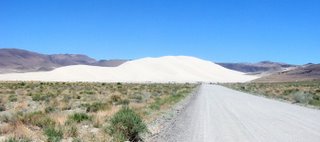
Sand Mountain, Nevada
THE EYE LIKES CONTINUITY-- continuity of line but also continuity of grain, and when it cannot have continuity it tries to feign it by filling in gaps. That's hard, though, and the eye fatigues. Christopher Alexander writes about this among his hundreds of architectural "patterns," recurring postulates he gleaned from observations of vernacular architecture in various cultures. "Half-inch trim," he calls it: ornament of a size sufficient to accommodate the ocular nervous system as it jumps from the grain of stone, plaster, or wood, on essentially plain surfaces, to the bigger events of corners, doorways, steps.
There's a lot of grain in the desert. Grain and grains. The sand ranges from almost a powder, at Sand Mountain -- about which more later -- to irregular grains recalling their origin in shell or stone. The stones themselves, worn and carried to these flat places, are of all sorts of color and texture.
But there are few flat places; the desert undulates, often imperceptibly, occasionally more certainly when washes wind across its surface. Here the finer grains have been swept away by water -- when might that last have happened, one wonders -- and the smallest "grains" are pebbles, the softest of them more rounded, water-worn.
Then there's the botanical grain. I'm no more a botanist than a geologist; I lack names for these things -- another failure of grain, of lexical grain this time. The rocks are all just rocks, or pebbles, or, ultimately, sand; the plants are all just brush, or bushes, or, rarely, flowers.
But you don't need literacy to appreciate the architecture of these plants, the feathery foliage attached one way or another to sticks that have followed some hidden instinct or influence in growing by twists and curves. Or their delightful palette, finding a hundred ways of mediating grey and green.
Or, for that matter, their instinct for location. For miles there will be little vegetation, and then the desert will fill with it, plants clustering closely or keeping their mutual distance, responding I suppose to the hidden ability of the soils to retain moisture. The plants on the flat desert are often different from those on hillsides, even adjacent and under the same huge sky.
Everything you see responds to some set of consistent influences, I'm sure of it; that's why everything in this desert looks "right." This in itself is reassuring and restful. Perhaps there's an implication that where such things as sand, rock, and brush inevitably find their proper place, determine themselves their proper distribution, why then all will ultimately be well with humans too, even the humans who stick these absurd fenceposts in the ground, and stretch out their rusty barbed wire to mature in the desert air.
But then you come upon Sand Mountain. Sand Mountain is an anomaly: an enormous pile of perfectly soft, perfectly white sand, limestone I imagine deposited somewhere else by a glacier distant in both time and space, ground into powder by unimaginable forces, and blown here and only here by currents of wind rising only at certain times (themselves determined by some secret agenda) and responding to the contours of the surrounding hills and mountains.
You turn off Highway 50 a few miles east of Fallon and follow a gravel road, perfectly straight and due north, to this pristine thing; and as you do your heart sinks a bit, or at least mine does, at the sight and sound of recreational vehicles -- motorcycle-like things but with four wheels, most of them -- scurrying along, not particularly fast, a few feet above the base of the sandpile; or occasionally, with a more strenuous snarl, riding straight up.
At the end of the gravel road, say a hundred yard from the mountain itself, is an improvised city of campers and trailers, a community whose citizens have only one purpose: to transport themselves in these mechanized crawlers across the sand. To do this they wear protective clothing: goggles, helmets, brightly-colored synthetic-cloth shirts, gloves. I'm sure they hear nothing but the unmuffled complaint of their engines; smell nothing but the hot-dirt-oil of their exhaust.
As to what they see, I can't imagine. Their view of nature must be constantly jostled and bumped; the glare of the sand and the brilliance of the sky must overcome the exquisite ocular system we humans have evolved, normally so sensitive to subtlety.
I suppose there's another layer of values in this community, a hierarchy (or at least a system) determined by the trappings these citizens surround themselves with. The Sierra Club published, years ago, a wonderful book of photographs of families posing in front of their residences and surrounded by all their possessions. This community recalled those photographs. These sand-bikers, let's call them, sit in front of their trailers and campers, shaded by improvised ramadas or patio umbrellas, coolers and things scattered about, sand-buggies parked nearby, helmets and gloves piled on their saddles or hanging from handlebars.
A glance reveals differences of economy: some of this stuff looks pretty trashy and well-used; some seems newer and fancier. But there seems no system to the distribution: this is clearly a transitional community, here for only one purpose, the strange rite of burning oil to travel purposelessly across these sands.
I write this a few days after seeing Sand Mountain -- and, after it, the isolated Nevada towns; the red-rock Utah country; sandstorms; the sudden nostalgic relief of the southwestern Colorado farmland; and the climax of Mesa Verde. All this has changed -- no, not changed, focussed -- the experience of Sand Mountain. Internet availability allowing, more on this to come.
No comments:
Post a Comment